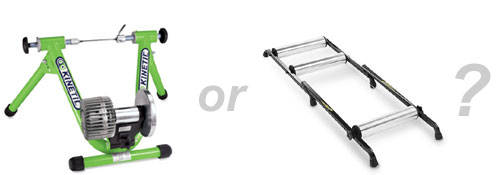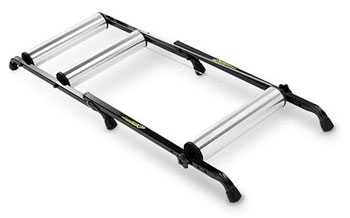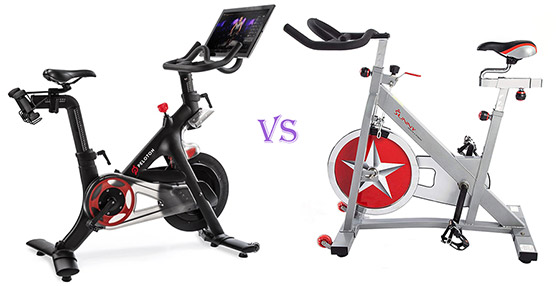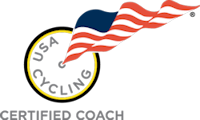
Most cyclists enjoy riding their bikes, so they like to ride year-round. But sometimes that is not feasible unless you ride inside. Riding outside during the winter is possible, and it can be lots of fun, but sometimes you just want to ride inside and avoid the hassle.
If that’s the case… have no fear! There are two popular options for indoor cycling – the stationary trainer, and rollers.
Here are the pros and cons of each:
Table of Contents
Stationary Bike Trainer

A stationary trainer is a device that attaches to your bicycle’s rear wheel. It holds the bike upright with the rear wheel off the ground, allowing you to ride in place.
The rear wheel is clamped against a roller to provide traction, and there is also a resistance unit attached to the roller, so you can train against heavy resistance levels if you wish.
Trainer Pros:
First, riding a trainer is stable. That’s because the bike is supported by the trainer. So if you are fairly new to riding, or just don’t want to worry about balance, a trainer provides that stability.
That also means you can easily stand, sprint, or even read a book while riding the trainer.
Also, say you want to ride even though you have a broken arm or dislocated shoulder. A stationary trainer is about the only way to do that without extra danger.
Second, you can dial up the resistance for a hard workout. Most trainers have an adjustable resistance unit, usually magnetic or fluid, which allows you to set a level of resistance to pedal against. If you want to push some big gears and do interval workouts, you can.
Finally, if you plan to do virtual group rides and races using Zwift, then a smart trainer is what you want.
Trainer Cons:
The problem with being so stable is that a trainer will not improve your balance. Since the bike is held in place, you don’t have to worry much about falling off, which is very different from outdoor riding! You can ride a trainer with poor balance and a sloppy pedal stroke, and you won’t even notice.
Also, your bike is clamped down pretty tight in one of these trainers. That poses two problems. First, the clamps can scratch and/or break your quick-release levers and possibly your frame. (My road bike’s frame lost a lot of paint chips the first time I clamped it into a trainer!)
Second, the rear tire will wear out very fast from all the pressure. If you are riding a trainer, plan to use some cheap, durable tires so you don’t ruin your good ones. ($5 tires are a good choice.) Or buy a specific “trainer tire.”
Bike Rollers

Rollers are a cross between a treadmill and a log rolling contest for your bike. Rollers consist of three drums held in a frame. Two drums go under your rear wheel and one under the front wheel, and there is a band connecting them so that your front wheel spins, too.
As you ride, the wheels spin the drums, and you effectively ride like usual, but you stay in one spot.
Rollers Pros:
Riding on rollers provides a very realistic feel. Since your bike is free to move around, it gives you that feeling of riding on the open road. That is a lot more fun than a trainer, where it feels like you’re stuck on an exercise bike.
That freedom of movement brings more benefits, too. It is also great for improving your balance. You have to consciously keep the bike upright, or you’ll fall over! It’s the same concept as balancing while riding outside, but since you’re not moving forward, it’s more difficult.
Similarly, you learn to ride in a straight line. Since the rollers are only 12-18″ wide, you need to ride in a straight line or you’ll fall off the edge. Being able to ride in a straight line is a vital skill for riding in a paceline, and rollers really help you with that.
Consequently, rollers are a great way to improve your pedal stroke. If you have a choppy pedal stroke that doesn’t apply power through the full pedal stroke, it will be very hard to stay balanced on the rollers. So you are forced to pedal in circles or you’ll fall over!
Lastly, there is no excess wear and tear on your bike. The only contact is between your tires and the smooth rollers. There is no extra pressure there, and the surfaces are smooth, so rollers are actually easier on your tires than riding outside.
Rollers Cons:
While rollers are so great for improving your riding skills, they are not beginner friendly. If you just ride your bike to burn some extra calories, you might not want to “fight” the rollers just to do a short ride.
Also, rollers usually don’t have a resistance unit. This can be a setback if you plan to do some very high-resistance interval workouts. (You can get a resistance unit for some rollers, although that can be expensive.)

My Recommendation: Rollers
I highly recommend rollers. Rollers are fun to ride and greatly improve your riding skills.
In my opinion, there really are no downsides to rollers. For example, the learning curve is a good thing because it forces you to become a better rider. And if you have absolutely terrible balance, you can get parabolic rollers, which make it much easier to stay upright, even if you stand and sprint.
You can also get a fork mount for rollers, which would stabilize the bike much like a trainer. So in the event you can’t physically ride the rollers (i.e. a broken arm) you could use this to transform them into a stationary trainer!
And the simple act of riding in the 53×11 combo provides enough resistance for my workouts. If you actually need more than that, you can get resistance units for certain models.
On the flip side, I think trainers are boring and make for excessive wear and tear on your bike.
No doubt, rollers are the way to go!
Pictured: Kurt Kinetic Trainer![]() | CycleOps Rollers
| CycleOps Rollers![]()
Levi Bloom is an experienced endurance athlete who has been training and competing for over 17 years. A former Cat 1 road and mountain bike racer (professional class on the regional circuit), he is now a cycling coach (USA Cycling Level 3 Certified) and sports nutrition coach (Precision Nutrition Level 1 Certified).







Nice try.. we train men to keep fit.. we don’t worry about tires.. we don’t worry about scratches on metal .. we concern about getting the job done. If a fellow wants to ride *his* bike and keep a few scratches in his back mind.. oh well.. We get to go back home and ride well with the folks and we can fix what broke.
Stat trainers are our best guess.
Good article, and I agree with you 100%. After owning both, the rollers are by far the best bet, simply because it is more realistic and works the muscles better. The only downside is if you are just in it for the exercise, not really racing, sometimes that extra work isn’t worth it, but like you said, the fork stabilizer is always an option.
You did miss one this, you can add resistance to rollers: link link
@Adam
I did mention resistance units. But yes, Minoura does make pretty good rollers with a resistance unit. That looks like a pretty good deal too, at under $250 for the rollers and resistance unit.
Kreitler rollers with resistance will set you back $550-600 and even the Performance Travel Trac inertial rollers with resistance are $300-400 depending on the sale price!
What is the cost of the stationary trainer. Thank you.
@Lou
Typically a good stationary trainer will be $250-300. There are lower quality cheaper ones and fancy expensive ones, though.
I just bought a trainer yesterday and just discovered rollers. I hope I didn’t make a mistake, but I guess I can always return the trainer for a roller.
Great write up and thanks for the link!
Speaking from experience i used both roller and turbo trainer in the past. Turbo gives a more harder workout and does not require much skill to ride. Very boring for me.
Roller on the other hand is more of a challenge to ride. Does wonders for your pedal action. Much less wear and tear on the bike. And you can really work up a sweat quickly. Once you master the technics of roller riding you can even stand out of the saddle and ride when using a fix gear (track bike)
I’m seriously thinking of going with rollers. However, I ride a TranceX full suspension bike and have concerns of the wheelbase measurement changing when I stand and crank out.
Am I over thinking this?
@Gary
You can’t just lock out the shock? I’ve never ridden a Trance X but I assume both the rear shock and fork have lockout levers.
That’s not to say it won’t be weird to ride a full suspension mountain bike on rollers, though.
The only thing weird about riding the rollers is my aggressive tires. Any recommendation on what tires to use?
Thanks
@Gary
Yeah, I remember my friend trying to learn on my rollers on his mountain bike with 2.3″ knobby tires. It’s an interesting sound! 🙂
If you’ll only be indoors, get the cheapest slicks you can find. I’ve used Forte tires for this purpose (a Performance Bike house brand.) I think they were $15 each and they’ve actually held up fine for me outdoors, too.
I have both. Cyclops fluid trainer and Kreitler rollers. I have to disagree on area. The rollers seem to wear both tires instead of just one. But they are deff more of a workout.
@Tdogg
That’s surprising. Even if I run some worn down racing tires on the rollers, they’ll go the whole winter/indoor season without any more noticeable wear.
Rollers teach you how to ride in a straight line smoothly and efficiently. We used to set up four sets that were connected by speedometer cables to a big “clock” with four hands. Each hand revolved as fast as you could pedal. Max gear allowed was 96.7. We would do 1500 meter races in less than 1 Min 15 seconds, approaching 60 mph while standing still. Did this at Malls for cycling publicity.
@Richard
That’s awesome! I’ve heard of roller races like that but never got to see them in real life.
please elaborate on the different diameter drums for rollers so newbies don’t get “the exact ones the pros use” (a VERY poor but common selection process for MANY things cycling related indeed).
@David
Good point. I agree, often the gear the pros use would be a terrible choice for anyone else!
Fortunately with rollers, most of them come with a nice drum around 3-4″ diameter. When available with smaller diameter drums, there is usually a warning about the extra difficulty.